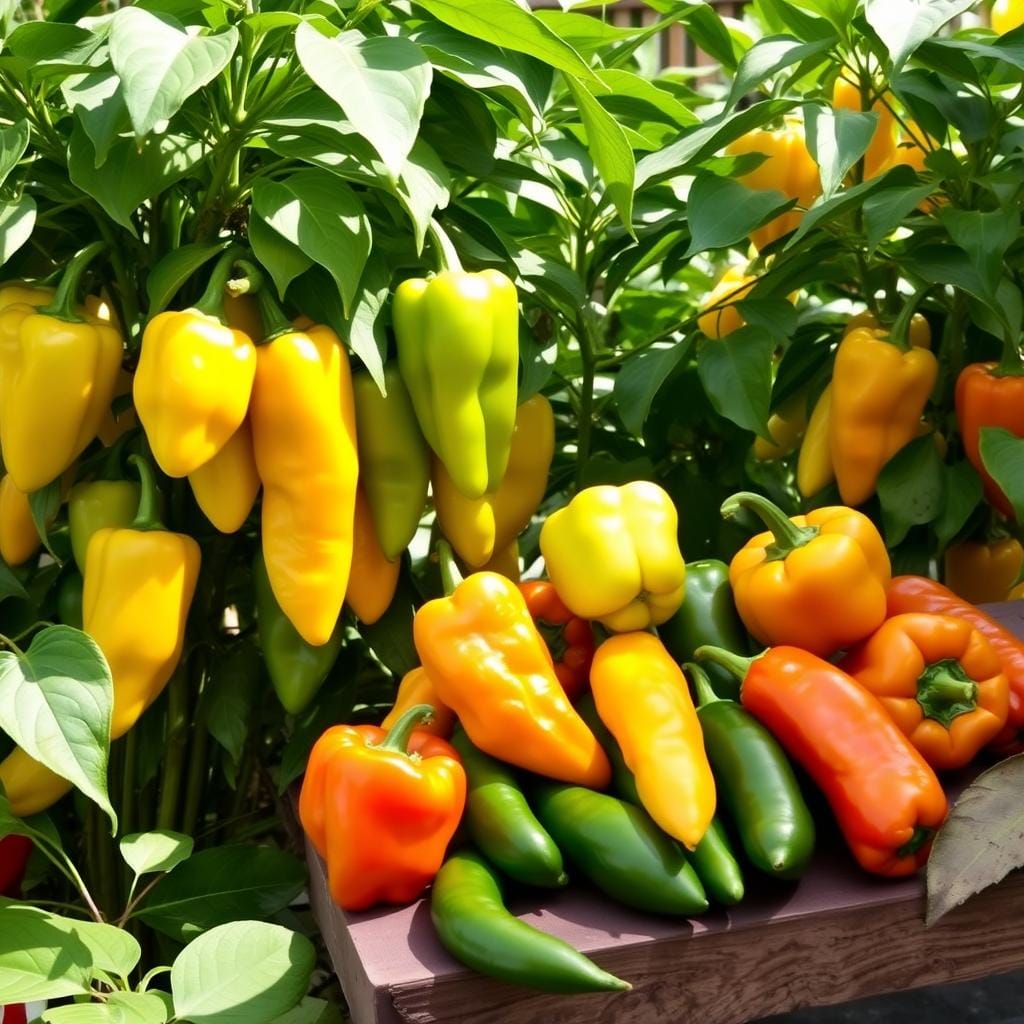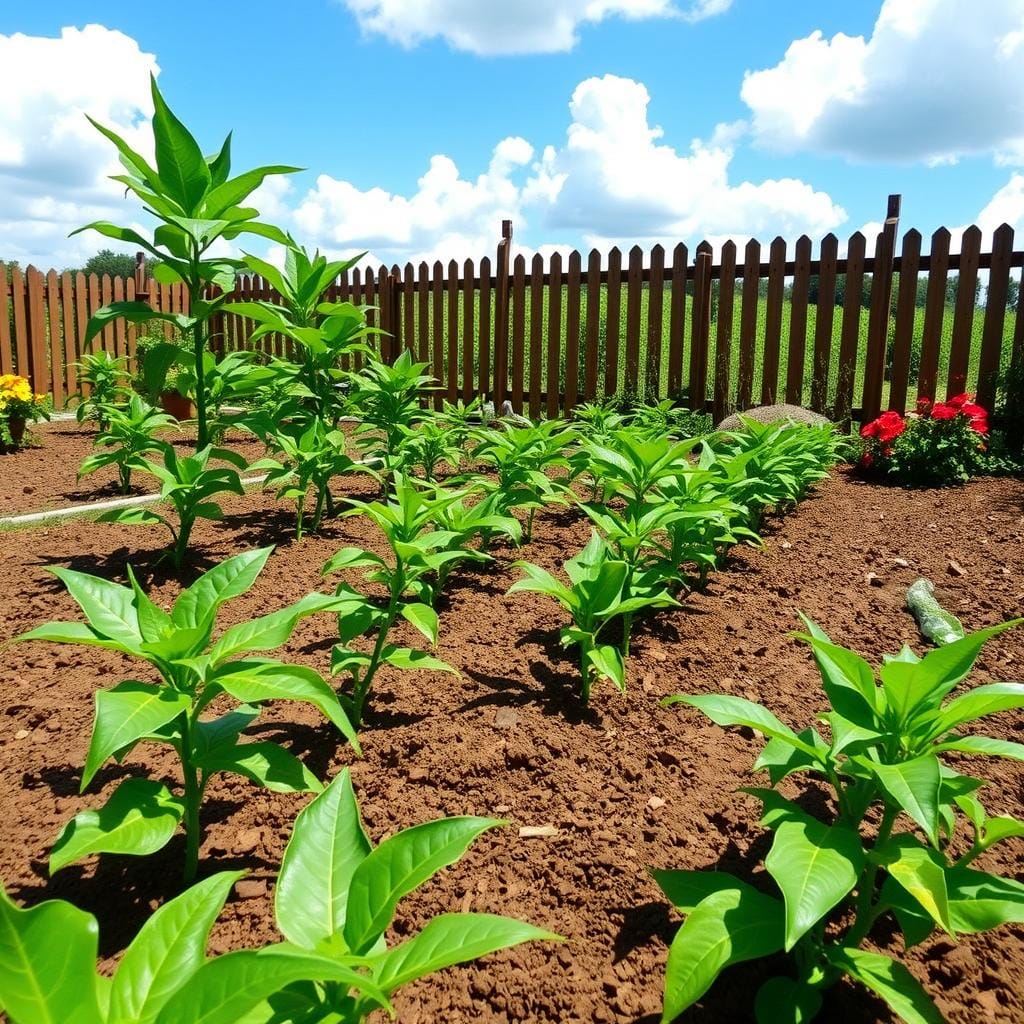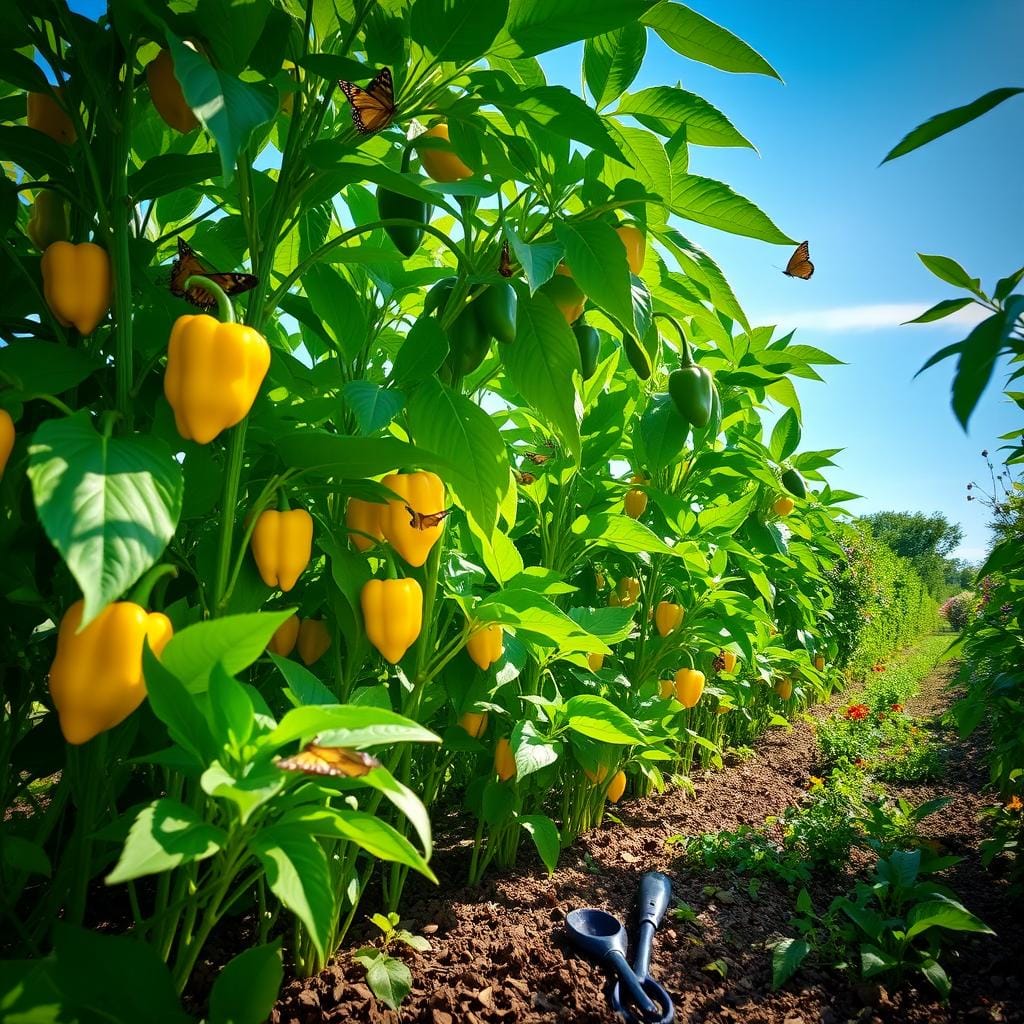My grandmother’s garden was a place of vibrant colors and delicious flavors. Banana peppers were her favorite, with their bright yellow-green color. They grew among tomatoes and basil, creating a special memory for our family.
Do you want to make zesty pepper relish or crunchy pepper rings? Growing banana peppers can turn your backyard into a gourmet spot. This guide will help you grow these tasty peppers, from picking seeds to harvesting your first batch.
Key Takeaways
- Banana peppers thrive in warm, sunny environments
- Proper soil preparation is crucial for successful growth
- Choose between sweet and hot pepper varieties
- Regular watering and fertilization ensure healthy plants
- Harvesting at the right time maximizes flavor potential
Understanding Banana Peppers: Varieties and Characteristics
Banana peppers are versatile and fascinating plants. They add unique flavor to gardens and kitchens across the United States. These peppers offer gardeners and culinary enthusiasts exciting options to explore.

When you explore banana peppers, you’ll find two main categories. These categories define their flavor and culinary potential.
Sweet vs. Hot Banana Pepper Types
Banana peppers come in two remarkable varieties. They cater to different taste preferences:
- Sweet Banana Peppers: Mild and tangy, perfect for fresh eating and pickling
- Hot Banana Peppers: Spicier version with a more intense heat level
Physical Characteristics and Growth Patterns
These peppers are easily recognizable. They resemble a banana with a bright yellow to orange color when ripe. Most banana pepper plants grow between 18-24 inches tall. They produce abundant fruit throughout the growing season.
Nutritional Benefits and Culinary Uses
Banana peppers are more than just a tasty addition to your meals. They’re packed with vitamins A and C. This makes them a nutritious choice for creating pickled peppers or zesty pepper spread. You can use them in various culinary applications:
- Fresh salads
- Sandwich toppings
- Homemade pepper spread
- Pickling recipes
“Banana peppers transform ordinary dishes into extraordinary culinary experiences” – Garden Fresh Cooking Magazine
Selecting the Perfect Growing Location

Finding the right spot is key for growing banana peppers. These plants need certain conditions to grow well and give lots of fruit. The best place will get lots of sunlight, protect from harsh weather, and have good growing conditions.
Sunlight is very important for banana peppers. They need 6-8 hours of direct sunlight every day. Find spots that get morning sun and some shade in the afternoon, especially in hot summers.
- Select locations with maximum sun exposure
- Avoid areas with strong wind currents
- Consider raised beds or containers for better control
- Ensure good air circulation around plants
Temperature is also very important. Banana peppers grow best in temperatures between 65-75°F. If it’s cooler where you live, use greenhouses or cold frames to protect your plants from frost.
“The secret to great banana peppers is giving them a home where they can bask in warmth and light.” – Gardening Expert
Think about the microclimate too. Places like brick walls, stone paths, and concrete can keep the area warm. This helps banana peppers grow strong roots and lots of fruit.
Essential Soil Requirements and Preparation
Growing banana peppers starts with knowing their soil needs. Your plants need the right soil to grow well and produce tasty fruits. These fruits can then be turned into zesty hot pepper sauce.
Getting the soil right is key for healthy banana peppers. A good growing medium is essential for strong plant growth.
Optimal Soil pH Levels
Banana pep
pers like slightly acidic soil, with a pH of 6.0 to 6.8. This pH helps plants take in nutrients well and grow strong roots. You can check your soil’s pH with home kits or professional services.
- Ideal pH range: 6.0 – 6.8
- Use lime to raise pH if too acidic
- Add sulfur to lower pH if too alkaline
Soil Amendment Techniques
Improving your soil involves adding organic matter and nutrients. Compost, aged manure, and organic fertilizers can make your soil perfect for banana peppers.
- Add 2-3 inches of organic compost
- Mix in well-rotted manure
- Include balanced organic fertilizers
Drainage Considerations
Drainage is crucial for banana peppers. Wet soil can cause root rot and slow growth. Use raised beds or add sand and organic matter to improve drainage.
“Great soil is the secret weapon of successful pepper growers.” – Professional Gardener
By focusing on these soil needs, you’ll create a great base for growing vibrant banana peppers. These can become the main ingredient in your homemade hot pepper sauce.
Starting Banana Peppers from Seeds
Growing banana peppers from seeds is a fun journey for gardeners. It starts with picking high-quality seeds from trusted sources. Choose seeds that fit your climate and taste preferences.
Starting seeds needs careful attention. Begin indoors 8-10 weeks before the last frost. Use seed trays or small pots with a good seed-starting mix.
- Select containers with drainage holes
- Use sterile seed-starting soil
- Maintain consistent moisture
- Keep soil temperature between 70-80°F
Germination for banana peppers takes 7-14 days. Use a seed heating mat for better results. Once sprouted, give them lots of light from a sunny window or grow lights.
| Seed Starting Stage | Key Requirements | Duration |
|---|---|---|
| Seed Preparation | Sterile soil, warm environment | Pre-germination |
| Germination | 70-80°F, consistent moisture | 7-14 days |
| Seedling Care | Adequate light, gentle watering | Until transplant |
As seedlings grow, thin them out to keep the strongest. This gives each plant enough space to grow well. Get ready for your pepper puree fans – these plants will soon produce lots of peppers!
“Patience and attention to detail are the secrets to successful seed starting.” – Experienced Gardener
Good care early on leads to a great banana pepper harvest. With hard work and the right methods, you’ll grow tasty banana peppers in your garden.
Transplanting and Spacing Guidelines
Growing banana peppers needs careful transplanting and spacing. Your plants need the right spot to grow well and give lots of tasty fruit.
Proper Plant Spacing Strategies
Spacing is key when moving banana peppers. Make sure each plant has enough space for strong roots and nutrients. Banana peppers should be:
- 18-24 inches apart in rows
- 24-36 inches between rows
- At least 12 inches from other veggies
Timing Your Transplants
Transplant banana peppers after the last frost. Soil should be at least 60°F. Timing is crucial for healthy growth.
| Transplant Phase | Recommended Conditions |
|---|---|
| Soil Temperature | 60-70°F |
| Time of Day | Late afternoon or early evening |
| Hardening Period | 7-10 days before transplanting |
Support Systems and Staking Methods
Banana peppers need support to grow straight and avoid fruit damage. Use:
- Sturdy tomato cages
- Bamboo stakes
- Vertical trellises
“Proper support helps banana peppers grow strong and produce maximum yields.” – Agricultural Extension Services
Follow these tips for a great banana pepper season. You’ll get lots of tasty fruit.
<h2>Watering and Irrigation Techniques
Growing healthy banana peppers needs the right watering. Your plants need steady moisture but not too much. Knowing how to water is key for great pepper marinade and crop quality.
- Maintain consistent soil moisture
- Avoid overhead watering
- Water deeply but infrequently
- Monitor soil drainage
The best way to water depends on several things. Drip irrigation is great for banana peppers. It sends water straight to the roots, saving water and preventing diseases.
“Consistent moisture is the secret to thriving banana pepper plants.” – Gardening Experts
How often you water changes as your plants grow. Young plants need more water, while older ones need less but deeper water. Aim for 1-2 inches of water a week, adjusting for your area and soil.
| Growth Stage | Watering Frequency | Water Amount |
|---|---|---|
| Seedling | Every 2-3 days | 1/2 inch |
| Established Plant | Weekly | 1-2 inches |
| Fruiting Stage | Consistent moisture | Adjust to soil conditions |
Pro tip: Always check soil moisture before watering. Stick your finger about two inches into the soil. If it feels dry, it’s time to water your banana peppers.
Fertilization and Nutrient Management
Growing healthy peppers needs a smart plan for nutrition. Your plants need certain nutrients to grow well and produce lots of tasty peppers. Knowing the best ways to fertilize can greatly improve your garden’s success.
Essential Nutrients for Pepper Growth
Banana peppers need a mix of nutrients to grow strong and produce tasty fruits. The main nutrients your plants need are:
- Nitrogen (N): Helps leaves and stems grow
- Phosphorus (P): Boosts root growth and flower production
- Potassium (K): Keeps plants healthy and improves fruit quality
<h3>Organic vs. Synthetic Fertilizers
When picking fertilizers for your banana peppers, you have two main choices:
| Organic Fertilizers | Synthetic Fertilizers |
|---|---|
| Slow-release nutrients | Quick nutrient absorption |
| Improves soil structure | Precise nutrient control |
| Environmentally friendly | Faster plant response |
Feeding Schedule Guidelines
For successful pickled peppers, a steady nutrition plan is key. Start fertilizing when your banana pepper plants are settled, usually 2-3 weeks after moving them. Use a balanced fertilizer every 4-6 weeks while they’re growing.
“Consistent nutrition is the secret to growing robust and flavorful banana peppers.” – Garden Experts
As peppers start to grow, cut back on nitrogen. This stops too much leaf growth and helps peppers grow better.
Common Pests and Disease Prevention
Growing healthy peppers needs careful pest management and disease prevention. Your plants face many challenges that can harm their health and productivity.
Spotting and fixing problems early can save your pepper plants. We’ll look at common issues and how to keep your plants safe.
Common Pests Affecting Banana Peppers
- Aphids: Tiny insects that cluster on leaf undersides
- Spider mites: Microscopic pests causing leaf discoloration
- Cutworms: Larvae that damage young pepper plants
- Whiteflies: Small flying insects that drain plant nutrients
Organic Pest Control Methods
- Neem oil spray for natural insect repellent
- Introduce beneficial insects like ladybugs
- Use companion planting techniques
- Implement sticky traps for monitoring
| Pest | Organic Treatment | Effectiveness |
|---|---|---|
| Aphids | Insecticidal soap | High |
| Spider Mites | Predatory mites | Medium-High |
| Whiteflies | Yellow sticky traps | Medium |
“Prevention is always better than cure when protecting your banana pepper plants.”
Keep your plants clean, watch them closely, and fix problems fast. This way, your banana peppers will stay healthy and grow well all season.
Disease Prevention Strategies
- Ensure proper soil drainage
- Practice crop rotation
- Remove infected plants immediately
- Use disease-resistant varieties
By using these pest management tips, you’ll keep your banana peppers safe and make your garden better.
Harvesting Your Banana Peppers
Growing peppers is a fun journey that ends with harvesting. Your plants will give you a tasty crop of bright peppers. You can make pepper relish or add them to your favorite meals.
Signs of Ripeness
It’s important to know when to pick your peppers. This ensures they taste great and are tender. Here are the signs to look for:
- Color change from green to yellow, orange, or red
- Firm but slightly soft texture
- Peppers reaching 4-6 inches in length
- Smooth, waxy surface without blemishes
Proper Picking Techniques
When you pick peppers, be gentle. This helps the fruit and the plant. Follow these steps:
- Use clean, sharp pruning shears
- Cut peppers with a short stem attached
- Avoid pulling or twisting, which can damage the plant
- Harvest in the morning when peppers are cool
Storage Methods
Long-term storage
| Storage Method | Duration | Best For |
|---|---|---|
| Refrigeration | 1-2 weeks | Fresh consumption |
| Freezing | 6-8 months | |
| Pepper Relish | 3-6 months | Preserved cooking |
To store banana peppers, keep them dry. Put them in a perforated plastic bag in the fridge’s crisper drawer. For longer storage, make pepper relish or freeze them.
Processing and Preservation Methods
After you pick your peppers, you’ll want to find ways to keep them fresh all year. There are many ways to use these peppers, like making tasty pepper spreads or vinegar.
Here are some top ways to keep your peppers:
- Pickling peppers for long-term storage
- Creating flavorful pepper spreads
- Drying peppers for seasoning and snacking
- Freezing whole or chopped peppers
Pickling is a great way to keep your peppers fresh for a long time. Pepper vinegar is perfect for making tangy, preserved peppers. It’s easy to do and you don’t need much equipment.
“Preservation is about capturing the peak flavor of your garden harvest and enjoying it year-round.” – Gardening Expert
To make pepper spreads, mix roasted banana peppers with cream cheese, garlic, and herbs. It’s all about trying different flavors to highlight the peppers’ sweetness.
Freezing is another good way to keep peppers. Just chop them and put them in airtight containers or bags. This way, they stay fresh and full of nutrients for months.
Always wear gloves when handling peppers and clean your tools well. This keeps your food safe to eat.
Conclusion
Growing peppers is fun and rewarding. It brings fresh, vibrant flavors right to your kitchen. You’ve learned how to grow these versatile veggies in your garden.
You now know how to make delicious hot pepper sauce. You can also try many new recipes. Whether you like sweet or spicy peppers, you’re ready to harvest a lot. A homemade banana bread recipe is a great addition to your pepper-growing journey.
Remember, growing peppers takes patience and dedication. Each season, you’ll learn more and get better at it. With time, you’ll know these plants well and have a steady supply of fresh peppers.
Start your banana pepper growing journey and enjoy the fresh flavors from your garden. Your hard work will pay off with a bountiful harvest. This will make you feel closer to your food and gardening skills.

